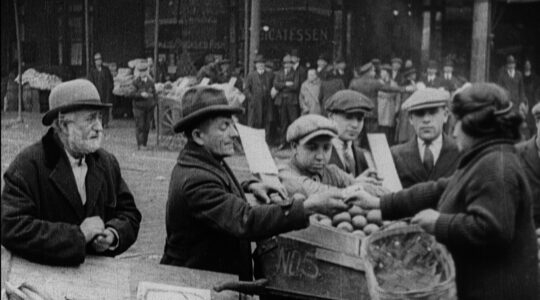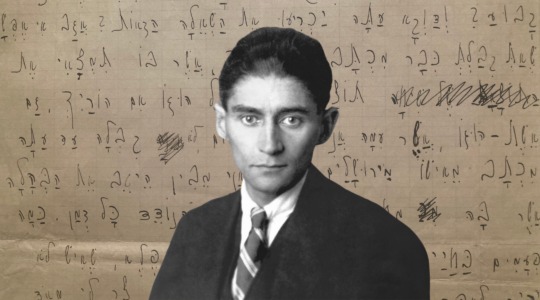In 1981, the Blessing of the Sun was reinvented by nocturnal Jews better acquainted with the moon: the artists, poets, musicians, writers, mystics and renegades who, like the old jazz joke, had long ago forgotten that there was also a 9 in the morning.
It was the year the blessing went from a dusty box in the Jewish attic to a pan-denominational phenomenon.
The blessing, said three times a century, marking the sun’s return every 28 years to its original point in the heavens, dates from Talmudic times. But for too long it was said, as was the more frequent Blessing of the Moon, only by a small cluster of Orthodox men, standing outside shul, alternately looking from siddur to sky.
It was recited by
sober men with their feet on the ground, in communities where there was no higher compliment than “he has his feet on the ground.”
In 1981, all that changed. A vague network of the neo-chasidic and spiritually nimble, informally led by Rabbis Zalman Schachter and Shlomo Carlebach, decided that it would be terrific to say the Blessing of the Sun with our feet off the ground, as close to the sun as possible, atop the Empire State Building.
Speaking by telephone from his Boulder, Colo., home, Reb Zalman mused that the idea was born in those summers when he’d take campers to mountaintops for daybreak davening. He liked the idea of “a shul” that gave you “the freedom to space out, in a way that is not interrupting our prayers but is following the prayers with our soul.”
So with the approach of the sun’s 206th round-trip, Reb Zalman wondered, “Where can we find a mountaintop in Manhattan?”
The Martin Steinberg Center, “a community of Jewish artists,” led by Yosef HaKohen (then known as Jeff Oboler), booked “a mountaintop,” the observation deck of the Empire State Building, for the morning of the blessing, April 8, 1981.
Reb Zalman, born in Poland in 1924, couldn’t remember anything special about the previous blessing in 1953.
Every generation gets its shot. In 1981 came the baby boomers, blessed or cursed with a profound fear of being bored or being boring. This was the generation that tried levitating the Pentagon; that turned a Catskill farm into Woodstock; that came like a gypsy circus into Central Park for — so quaint does it sound now — “be-ins” and “happenings.” It was a generation raised on street theater, performance art, like Kerouac’s desolation angels in perpetual search of a scene.
It was a generation from whose energy Reb Zalman, the Steinberg Center and New Jewish Times, an alternative paper, was emerging, except with less Jewish naiveté and greater Jewish dignity.
Spiritual guidance also came from Arthur Waskow’s “Menorah” newsletter; from ArtScroll; from Rabbi Nehemia and Laurie Polen in Massachusetts.
This informal network said the blessing in 1981 at folk shrines and icons, everywhere except at a synagogue: in the Redwood forest, on the dock of the bay, at the Jefferson Memorial, at the Golden Gate Bridge, atop the Rockies, down by riversides, balancing on the Cape Cod rocks lapping the Atlantic waters, as close as you could possibly get to the sunrise horizon.
A few went to the roof of the World Trade Center. Perhaps their souls are up there still.
And yet, for all the excitement, you could probably fit all of these ad hoc minyans into Yankee Stadium’s left-field bleachers.
Jewish newspapers pretty much ignored the blessing or buried it. After all, they must have figured, what’s news about a blessing? On the other hand, New Jewish Times (a newspaper edited by Yossi Klein Halevi, Izzy Lemberg and myself) started providing information and resource guides as early as February.
In 2009, New Jewish Times was remembered romantically by both Haaretz and The New York Times for declaring its “independence from the norms of Jewish journalism,” reporting “presciently,” said Times columnist Sam Freedman, on the emerging Chabad and Jewish Renewal movements. Reb Zalman was a fusion of the two.
“I’ll tell you,” Reb Zalman says today, “We have to give credit to the [Lubavitcher] rebbe. The rebbe always pushed, What can you do to get out of your habit? How do you break through the usual to reach your full consciousness?”
In a stiff recession, New Jewish Times died just days before the blessing. We, who had a financial stake in the paper, were lowdown broke, spending the nights before the blessing taking stationery and promotional items from the office, in lieu of a final paycheck.
In truth, not too many people were paying attention to the paper or the Steinberg Center. No more than 300 of us came to the Empire State Building where, by special arrangement, the observation deck was opened at 5 a.m.
Some brought guitars, singing “Here Comes The Sun,” and Hair’s “Let The Sun Shine In.”
Some put on tallis and tefillin in the northeast corner, closest the horizon. Halevi, in his “Memoirs of a Jewish Extremist,” remembers that “below us was a city of gray towers. The distant streets were still,” the observation deck indeed seemed “like a mountain peak,” at the end of night. “One man wore a rainbow-striped prayer shawl wrapped around his head like a Bedouin; another carried a tefillin bag on which was stitched the word ‘Tibet.’ Some women wore prayer shawls and yarmulkes. … I wrapped myself in the [tallis] and tefillin that belonged to my father and in which I routinely prayed. [Sara] stood beside me; I extended my prayer shawl over her shoulders, to protect her from the wind.”
To the south, one could see dim lights on freighters in Sandy Hook Bay; to the north, the shadowy Palisades hulking over the Tappan Zee; to the east, the birth of morning over Long Island Sound.
The sky turned from tar-black to charcoal. Some cheered but then hushed, in awe, as if we were witnessing the 16th verse of Genesis. In the eastern firmament appeared a small rosette, particles of indigo, vermilion, shards of argent, crimson daybreak.
Reb Zalman blew a shofar, crying out, may this blessing “bring a healing for ourselves and for our planet, good crops and solutions to our economic problems. … Master of the Universe, whatever we can fix, please God, show us how. And whatever we can’t fix anymore, have rachmones, a little pity on us, and fix it yourself.”
Reb Zalman remembers, “We read the fourth day of Creation from a Sefer Torah, said some Hallel, and released 70 balloons,” evoking the 70 bulls sacrificed on Sukkot for the mythical 70 nations of the world, “as if to say that we aren’t just interested in ourselves and what we need, but we were interested in the world.”
The world took little note. The New York Times covered the spectacle with a few paragraphs, but The Jewish Week & American Examiner, a pale ancestor of today’s paper, had nothing the following week.
Without New Jewish Times, I sold a piece to The New Yorker about the blessing, but it never ran. Halevi wrote a piece for The Village Voice, when it was still a great paper, but they, too, accepted the story before deciding it was not a story, either.
The Steinberg Center lost its funding, fairly soon after, and closed its doors.
Reb Zalman went back to being considered, along with Reb Shlomo, brilliant but fringe, chasidic outlaws unfit for slick company. It would be a while before Carlebach minyans, or Reb Zalman’s eco-kashrut and halachic-organic understanding of the world, would enter the mainstream.
As Reb Zalman joked, “I felt like the gonif geshnitin fun der tliya – when you need a thief you cut him from the gallows.”
On that holy morning, at rush hour, people started taking the elevator down to street level, except those of us who had no paper, no readers, no job or place to go. We lingered in the quiet, high over the city, halfway to heaven. There was nowhere to go but up.
The New York Jewish Week brings you the stories behind the headlines, keeping you connected to Jewish life in New York. Help sustain the reporting you trust by donating today.




